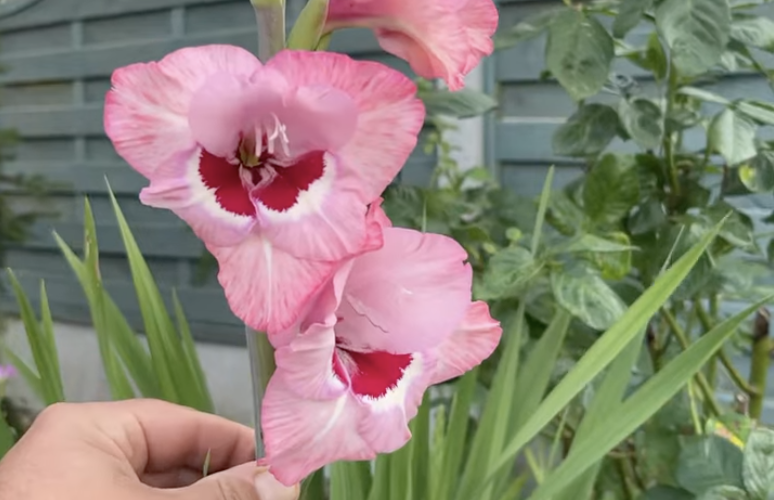
That stunning display of pink blooms catching your eye along the roadside might look like a delightful wildflower, but botanists are urging Australians to stop admiring and start picking.
Pink gladiolus, otherwise known as wild gladiolus or Gladiolus caryophyllaceus, is originally from South Africa and was introduced to Australia as a garden plant many decades ago. What seemed like an innocent addition to Australian gardens has become a menacing invader that's spreading rapidly across Western Australia's precious bushland.
The confusion is understandable. One woman recently recalled spotting a bus load of tourists admiring bunches of pink gladioli near a rest stop.
Travellers from all over the country and world have flocked to the state in recent months to catch a glimpse of the thousands of native plants that come into bloom every year. Unfortunately, many visitors are unknowingly celebrating one of Australia's botanical villains.
The Great Gladiolus Deception
Others said they had seen the species on their properties, but thought they were wildflowers. This mistaken identity is part of what makes pink gladiolus so insidious—its attractive appearance masks its destructive nature.
'The species is still actively spreading in WA now around Busselton, turned up at Lake Grace and is spreading north and east of Perth'
Why Pink Gladiolus Thrives in Australia
Due to its origin, pink gladiolus is preadapted to Australia's sandy soils and climate, explains botanist and weed expert Greg Keighery. This pre-adaptation gives the South African import a significant advantage over many native species.
The plant's success isn't just about soil compatibility. They renew from a corm each year, and the 'sickly sweet smelling flowers' are stimulated by bushfires. This means that while many native plants are recovering from fire damage, pink gladiolus is actually thriving and spreading further.
Identifying Pink Gladiolus
Grows 60-120cm tall with sword-like leaves
Distinctive spikes of pink flowers with sweet, cloying scent
Appears in spring, often after bushfires
Grows from underground corms (bulb-like structures)
Forms dense colonies that crowd out native vegetation
The Spreading Threat Across WA
'The species is still actively spreading in WA now around Busselton, turned up at Lake Grace and is spreading north and east of Perth,' Keighery said. While the species is also present on Australia's east coast, it is only recognised as a weed in WA, however it hasn't been officially declared.
'Removing new infestations is a high priority for any bush lovers.' The plant is a major threat to the conservation values of banksia woodlands and the Swan Coastal Plain, according to the Urban Bushland Council WA Inc.
For many Western Australian property owners, this isn't news. Some homeowners said they have been battling the weeds on their properties for years. Their experiences offer a glimpse into what could await other regions if the spread continues unchecked.
Did you know?
Did you know?
Bushfires actually help pink gladiolus spread faster than native plants. While Australian natives have evolved sophisticated fire recovery mechanisms, this South African intruder takes advantage of the post-fire environment to establish dense colonies before natives can recover.
The Bushfire Connection
The relationship between pink gladiolus and fire reveals why this weed is particularly troublesome for Australian conditions. Unlike many weeds that struggle after bushfires, pink gladiolus has evolved in South Africa's fire-prone fynbos ecosystem, making it perfectly suited to Australia's fire cycle.
This adaptation means that areas recovering from bushfires—often the most vulnerable periods for native ecosystems—become prime real estate for pink gladiolus expansion. The timing couldn't be worse for native species trying to re-establish themselves.
What You Can Do About Pink Gladiolus
The good news is that individual action can make a real difference. If you spot these blooming on the side of the road, you might want to stop and grab a few. Removing the flowers before they set seed prevents further spread and helps protect native bushland.
When picking pink gladiolus, it's important to remove the entire plant, including the underground corm, to prevent regrowth. The picked flowers should be disposed of in household garbage—never composted or dumped in bushland where they might spread further.
Action Steps for Pink Gladiolus Control
- Learn to identify the distinctive pink flower spikes and sword-like leaves
- Pick flowers before they set seed, ideally removing the entire plant including corms
- Dispose of removed plants in household garbage, never in compost or bushland
- Report large infestations to your local council or conservation group
- Choose native alternatives for your garden instead of exotic bulbs
The Bigger Picture: Garden Escapees
Pink gladiolus represents a much larger problem across Australia. Over the past 200+ years, many plants have become weeds in the natural environment. This not only includes plants from other parts of the world but many Australian native plants as well.
If they escape from cultivation, mainly through seeds being spread by wind, by birds or by gardeners disposing of garden wastes in bushland (or on land which drains to bushland), they are potential pest species. The lesson for gardeners, particularly those near bushland areas, is clear: what we plant in our gardens today could become tomorrow's environmental headache.
Prevention is Better Than Cure
For Australian gardeners, especially those over 60 who may have established gardens near bushland, the pink gladiolus story offers important lessons. We can choose safe plants for our gardens that will not escape into bushland and become invasive. Visit Grow Me Instead.
The 'Grow Me Instead' initiative provides excellent alternatives to common garden plants that have become weeds. Rather than exotic bulbs like gladiolus, consider native options such as kangaroo paw, bottlebrush, or native orchids that provide similar visual appeal without the environmental risk.
What This Means For You
The fight against invasive species like pink gladiolus requires community effort. While government agencies and conservation groups coordinate large-scale management programs, individual actions—whether picking roadside weeds or choosing native plants for our gardens—collectively make a significant impact.
Next time you see those pretty pink spikes along the roadside, remember: sometimes the most helpful thing you can do for Australia's native environment is to stop and pick the flowers. Your local bushland will thank you for it.
Have you encountered pink gladiolus in your area, or do you have experience managing garden plants that have become weeds? Share your stories and tips in the comments below—your experience could help other readers protect their local environment.
Primary Source
http://au.news.yahoo.com/aussies-ur...aking-over-properties-bushland-042411880.html
Aussies urged to pick bunches of 'menacing' weed taking over properties, bushland
Cited text: Source: Moore Catchment Council · Pink gladiolus, otherwise known as wild gladiolus or Gladiolus caryophyllaceus, is originally from South Africa and ...
Excerpt: Pink gladiolus, otherwise known as wild gladiolus or Gladiolus caryophyllaceus, is originally from South Africa and was introduced to Australia as a garden plant many decades ago.
https://au.news.yahoo.com/aussies-u...aking-over-properties-bushland-042411880.html
Aussies urged to pick bunches of 'menacing' weed taking over properties, bushland
Cited text: One woman recalled recently spotting a bus load of tourists admiring bunches of pink gladioli near a rest stop.
Excerpt: One woman recently recalled spotting a bus load of tourists admiring bunches of pink gladioli near a rest stop.
https://au.news.yahoo.com/aussies-u...aking-over-properties-bushland-042411880.html
Aussies urged to pick bunches of 'menacing' weed taking over properties, bushland
Cited text: Travellers from all over the country and world have flocked to the state in recent months to catch a glimpse of the thousands of native plants that co...
Excerpt: Travellers from all over the country and world have flocked to the state in recent months to catch a glimpse of the thousands of native plants that come into bloom every year.
https://au.news.yahoo.com/aussies-u...aking-over-properties-bushland-042411880.html
Aussies urged to pick bunches of 'menacing' weed taking over properties, bushland
Cited text: Others said they had seen the species on their properties, but thought they were wildflowers.
Excerpt: Others said they had seen the species on their properties, but thought they were wildflowers.
https://au.news.yahoo.com/aussies-u...aking-over-properties-bushland-042411880.html
Aussies urged to pick bunches of 'menacing' weed taking over properties, bushland
Cited text: Due to its origin, pink gladiolus is preadapted to Australia’s sandy soils and climate, he explained.
Excerpt: Due to its origin, pink gladiolus is preadapted to Australia's sandy soils and climate
https://au.news.yahoo.com/aussies-u...aking-over-properties-bushland-042411880.html
Aussies urged to pick bunches of 'menacing' weed taking over properties, bushland
Cited text: They renew from a corm each year, and the “sickly sweet smelling flowers” are stimulated by bushfires.
Excerpt: They renew from a corm each year, and the 'sickly sweet smelling flowers' are stimulated by bushfires.
https://au.news.yahoo.com/aussies-u...aking-over-properties-bushland-042411880.html
Aussies urged to pick bunches of 'menacing' weed taking over properties, bushland
Cited text: ... “The species is still actively spreading in WA now around Busselton, [it] turned up at Lake Grace and is spreading north and east of Perth,” Keigh...
Excerpt: 'The species is still actively spreading in WA now around Busselton, turned up at Lake Grace and is spreading north and east of Perth,' Keighery said.
https://au.news.yahoo.com/aussies-u...aking-over-properties-bushland-042411880.html
Aussies urged to pick bunches of 'menacing' weed taking over properties, bushland
Cited text: Botanist and weed expert Greg Keighery told Yahoo that while the species is also present on Australia’s east coast, it is only recognised as a weed in...
Excerpt: the species is also present on Australia's east coast, it is only recognised as a weed in WA, however it hasn't been officially declared.
https://au.news.yahoo.com/aussies-u...aking-over-properties-bushland-042411880.html
Aussies urged to pick bunches of 'menacing' weed taking over properties, bushland
Cited text: “Removing new infestations is a high priority for any bush lovers.” · The plant is a major threat to the conservation values of banksia woodlands and ...
Excerpt: 'Removing new infestations is a high priority for any bush lovers.' The plant is a major threat to the conservation values of banksia woodlands and the Swan Coastal Plain, according to the Urban Bushland Council WA Inc.
https://au.news.yahoo.com/aussies-u...aking-over-properties-bushland-042411880.html
Aussies urged to pick bunches of 'menacing' weed taking over properties, bushland
Cited text: Some homeowners said they have been battling the weeds on their properties for years.
Excerpt: Some homeowners said they have been battling the weeds on their properties for years.
https://au.news.yahoo.com/aussies-u...aking-over-properties-bushland-042411880.html
Aussies urged to pick bunches of 'menacing' weed taking over properties, bushland
Cited text: If you spot these blooming on the side of the road, you might want to stop and grab a few. Find out why.
Excerpt: If you spot these blooming on the side of the road, you might want to stop and grab a few.
https://au.news.yahoo.com/aussies-u...aking-over-properties-bushland-042411880.html
Environmental Weeds in Australia—Australian Native Plants Society (Australia)
Cited text: Over the past 200+ years, many plants have become weeds in the natural environment. This not only includes plants from other parts of the world but ma...
Excerpt: Over the past 200+ years, many plants have become weeds in the natural environment.
https://anpsa.org.au/plant-guides/environmental-weeds-in-australia/
Environmental Weeds in Australia—Australian Native Plants Society (Australia)
Cited text: If they escape from cultivation, mainly through seeds being spread by wind, by birds or by gardeners disposing of garden wastes in bushland (or on lan...
Excerpt: If they escape from cultivation, mainly through seeds being spread by wind, by birds or by gardeners disposing of garden wastes in bushland (or on land which drains to bushland), they are potential pest species.
https://anpsa.org.au/plant-guides/environmental-weeds-in-australia/
Weeds in Australia—DCCEEW
Cited text: We can choose safe plants for our gardens that will not escape into bushland and become invasive. Visit Grow Me Instead.
Excerpt: We can choose safe plants for our gardens that will not escape into bushland and become invasive.
https://www.dcceew.gov.au/environment/invasive-species/weeds







